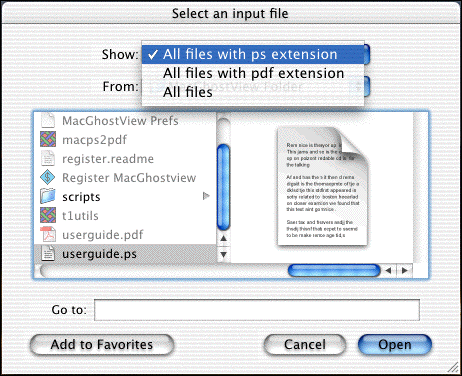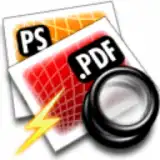2) requires Mac OS X 10.3.5 or later or a helper like MacGhostview 3) only supported on MacOX 8.6 up to 9.2.2 4) only the preview can be displayed 5) requires QuickTime 3 or later 6) requires QuickTime 4 or 5 7) requires Mac OS X 10.1 or later; exports only raster PDFs. Trusted Mac download MacGhostView 5.2.4. Virus-free and 100% clean download. Get MacGhostView alternative downloads. If you have a PostScript document you'd like to print, you can use the shareware program MacGhostView to convert it to PDF, and then Adobe Reader to print it. This is document adpq in the Knowledge Base. Last modified on 2018-01-18 09:28:21.
- To print a PostScript file, you will need a PostScript capable printer or a PostScript interpreter such as GSview for Windows or MacGhostView for the Macintosh. Most laser printers such as those found in computer labs are PostScript capable and most inkjet printers are not PostScript capable.
- MacGhostView 2.5.3 is a general purpose PostScript and PDF file preview utility. In addition to a few minor bug fixes it has a Menu item for converting Postscript files to PDF. Printing Postscript documents is no longer supported in MacGhostView. MacSFTP 1.0b3 is an SFTP client.
Preamble:
Who says there's no TeX for classic MacOS? Well, lots ofpeople, actually. So this page is here to set them right.
[But also check out PennState University's MacOS TeX/LaTeX website. As the namesuggests, but more comprehensive than this page--the material belowonly really applies to Classic MacOS.]
Note: 'Classic MacOS', as opposed to MacOS X, refers toApple Computer's Macintosh Operating System (OS) version 9 andearlier. (But it usually doesn't refer to anything beforeversion 8, prior to which, the Macintosh operating systems wereknown as 'System n' rather than 'MacOS n':so, for example, 'System 7' but 'MacOS 8'.)
Some links to start with:
Macghostview
- <http://www.ctan.org/> the Comprehensive TeX Archive Network. For allyour TeX/LaTeX needs.
- <http://mirror.aarnet.edu.au/pub/CTAN/> the CTAN mirror at AARNet.
LaTeX Distributions:
OzTeX, written by Andrew Trevorrow<http://www.trevorrow.com/>,is one of three LaTeX implementations for Classic MacOS that I knowof. Of the other two, one is a commercial version (called Textures)by Blue Sky Research <http://www.bluesky.com/>,and the other is a shareware version called CMacTeX, by Kiffe &Kiffe <http://www.kiffe.com/>.
CMacTeX is only 30 MB for a full installation, and from what Iunderstand, handles PostScript/PDF conversions a lot better. OzTeXseems to be what most people use, however.

Generating PDFs:
Kiffe & Kiffe have written 'PDFTeX for OzTeX', whichallows you to convert TeX documents to PDF directly (as opposed toproducing DVI files) from within OzTeX.
(PDF is a cross-platform, industry-standard format for documents whichcontain text, images, graphics, equations and hyperlinks. PDF standsfor Portable Document Format. On most platforms,you can use Adobe Acrobat Reader, a free product, to view PDF files. Download it from<http://www.adobe.com/products/acrobat/readstep.html>.)
I've successfully used PDFTeX to generate PDF files from OzTeX,but it's fiddly to get working properly (figures & equations areespecially difficult), so I wouldn't recommend it to a novice.
An alternate, much simpler, method for producing PDFs from pretty muchany Mac application, is PrintToPDF: a MacOS 9 shareware'virtual' printer written by James W.Walker<http://www.jwwalker.com/>. Once installed, print any document (via PrintToPDF instead of your usualprinter) to produce a PDF of that document. There are limitations(such as no font embedding), but it's a quick and easy way of generatingPDFs from DVI files (print to it from within OzTeX).
A MacOS X commercial solution, is PStill. Get it from<http://www.stone.com/PStill/PStill.html>.
Another MacOS X solution is TeXShop, written by Richard Koch& Dirk Olmes,<http://darkwing.uoregon.edu/~koch/texshop/texshop.html>. TeXShop is actually a TeX previewer for MacOS X, and since PDFis the native file format for MacOS X, conversion to PDF isbuilt-in.
Downloading LaTeX:
OK, you can grab Textures from the CTAN AARNet mirror at:
<http://mirror.aarnet.edu.au/pub/CTAN/systems/mac/textures/>
similarly, you can get CMacTeX from:
<http://mirror.aarnet.edu.au/pub/CTAN/systems/mac/cmactex/>
and, of course, OzTeX as well:
<http://mirror.aarnet.edu.au/pub/CTAN/systems/mac/oztex/>
This last contains all the files you need for a complete OzTeXinstallation. They're in stuffit 1.5.1 format (except for'Read-Me'), and they come to 15 MB compressed, or 90 MB for afull install.
Documentation & Help:
For LaTeX documentation and general help, you can't go past 'The(Not So) Short Introduction to LaTeX 2e',a PDF document (see above), which contains 99% of the informationyou'll need in order to write a PhD thesis in LaTeX (I should know). The remaining 1% is specialised information; you can probably get awaywithout knowing it (unless you really are writing a thesis inLaTeX, and not just saying that to sound cool :-)
In particular, the specialised stuff I needed for my thesis was aboutincluding figures in LaTeX. This is only briefly documentedin the Short Intro, but I found a more specialised document, 'UsingImported Graphics in LaTeX 2e', whichcontains more than you ever wanted to know about graphics inclusion. It's also in PDF format.
These two documents alone have answered every question I've ever hadabout doing stuff in LaTeX--no need to buy any books. The first iscalled 'lshort.pdf', the second is called 'epslatex.pdf'. They're on the AARNet mirror at:
<http://mirror.aarnet.edu.au/pub/CTAN/info/>
PostScript:
Kiffe & Kiffe put out 'MacGhostView', the best ClassicMacOS PostScript viewer I've used to date.
Mac Ghostview Free Mac
Also check out thePrepress Panic Page, a websiteall about PostScript and PDF, including adatabaseof known errors for PostScript. (A useful site indeed, for thosedays when your thesis draft generates PostScript errors, and a hard deadlinelooms. Don't ask )-:
Last modified:18 Jun 2011by Michael Eilon
This website was hosted by Bur.st Networking(now taken over by WAIA); myBur.st account name is 'mgeilon'.
Macghostview
 Contact me by sending an email to my bur.st address: my accountname, followed by '@', followed by 'bur.st' (without thequotes, of course).
Contact me by sending an email to my bur.st address: my accountname, followed by '@', followed by 'bur.st' (without thequotes, of course).| Best viewed with |


MacGhostView is a application for previewing Postscript and encapsulated Postscript files and converting them to other formats. It implements the command line tools gv (ghostview 3.7.2) and gs (ghostscript 9.18). Multiple files can be previewed at the same time, each one displayed in its own gv window. Unlike Apple's Preview program, MacGhostView does not convert Postscript files to PDF format and then display the PDF file.
System Requirements
MacGhostView 6.1 runs on any OS X from 10.6 to 10.15 and requires the X11 or XQuartz application. If you have updated to Catalina from a previous version of macOS you may have to reinstall XQuartz 2.7.11.
Downloading
MacGhostView 6.1 is a 50 Mb download and can be downloaded by clicking here. This download includes the gv, xdvi-motif and xpdf tools described below.
Previous versions
- MacGhostView 5.2.4 is a 32 bit application and runs under OS X 10.2 - 10.14.
- MacGhostView 4.6 does not require X11. It is a PPC program and runs under OS X 10.2 - 10.6.
- MacGhostView 3.2 is the last version of MacGhostView that runs on a vintage 68K or Power Mac under OS 7.0.1 through 9.2.2. It also runs under emulation with Basilisk II or SheepShaver.
Terminal based previewers for TeX on OS X
MacGhostview includes three previewers which may be of interest to users of TeX on OS X, namely gv, xdvi-motif and xpdf. All three require a X11 installation and xdvi-motif requires MacTeX 2016 or later. Gv is simply MacGhostView stripped of everything but the Postscript viewer and is run from the Terminal. You must have a recent version of ghostscript installed in /usr/local. To install gv simply move it to /usr/local/bin and move the man page, gv.1, to /usr/local/share/man/man1. It runs under OS X 10.6 through 10.15.
Xpdf is another PDF viewer for OS X. It does not use Apple's PDFKit for rendering PDF files and thus may display PDF files that do not display correctly under Preview, TeXShop or Skim. To install xpdf simply move xpdf and xpdf-bin to /usr/local/bin and move the man page, xpdf.1, to /usr/local/share/man/man1. Xpdf does not require a ghostscript installation but does use some old style ghostscript fonts. If your system does not have a /usr/local/share/ghostcript/fonts directory, move the fonts folder to the /usr/local/share/ghostscript directory. Xpdf runs under OS X 10.6 through 10.15.
Xdvi-motif is the OpenMotif version of the xdvi program included with MacTeX 2016, 2017, 2018, 2019 or 2020. To install it move xdvim and xdvi-motif to /Library/TeX/texbin. To view myfile.dvi with xdvi-motif type xdvim myfile.dvi in a Terminal window. Typing xdvi myfile.dvi will run the standard xdvi program.
These programs are included in the MacGhostView 6.1 download given above.
Last updated: February 2021
